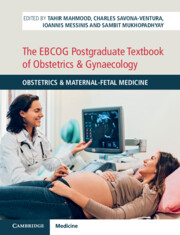Book contents
- The EBCOG Postgraduate Textbook of Obstetrics & Gynaecology
- The EBCOG Postgraduate Textbook of Obstetrics & Gynaecology
- Copyright page
- Dedication
- Contents
- Contributors
- Preface
- Section 1 Basic Sciences in Obstetrics
- Section 2 Early Pregnancy Problems
- Section 3 Fetal Medicine
- Section 4 Maternal Medicine
- Section 5 Intrapartum Care
- Chapter 43 Normal Labour
- Chapter 44 Issues during Labour for Migrant Populations
- Chapter 45 Prolonged Pregnancy
- Chapter 46 Induction of Labour
- Chapter 47 Intrapartum Fetal Monitoring
- Chapter 48 Augmentation of Labour
- Chapter 49 Analgesia and Anaesthesia during Labour
- Chapter 50 Preterm Labour
- Chapter 51 Management of Multiple Pregnancy during Labour
- Chapter 52 Abnormal Obstetric Presentation
- Chapter 53 Intrapartum Emergencies
- Chapter 54 Caesarean Section
- Chapter 55 Instrumental Operative Obstetrics
- Chapter 56 Maternal Collapse in Labour
- Chapter 57 Management of Postpartum Haemorrhage
- Chapter 58 Birth Injuries and Perineal Trauma
- Chapter 59 Management of Stillbirth
- Section 6 Neonatal Problems
- Section 7 Placenta
- Section 8 Public Health Issues in Obstetrics
- Section 9 Co-Morbidities during Pregnancy
- Index
- Plate Section (PDF Only)
- References
Chapter 48 - Augmentation of Labour
from Section 5 - Intrapartum Care
Published online by Cambridge University Press: 20 November 2021
- The EBCOG Postgraduate Textbook of Obstetrics & Gynaecology
- The EBCOG Postgraduate Textbook of Obstetrics & Gynaecology
- Copyright page
- Dedication
- Contents
- Contributors
- Preface
- Section 1 Basic Sciences in Obstetrics
- Section 2 Early Pregnancy Problems
- Section 3 Fetal Medicine
- Section 4 Maternal Medicine
- Section 5 Intrapartum Care
- Chapter 43 Normal Labour
- Chapter 44 Issues during Labour for Migrant Populations
- Chapter 45 Prolonged Pregnancy
- Chapter 46 Induction of Labour
- Chapter 47 Intrapartum Fetal Monitoring
- Chapter 48 Augmentation of Labour
- Chapter 49 Analgesia and Anaesthesia during Labour
- Chapter 50 Preterm Labour
- Chapter 51 Management of Multiple Pregnancy during Labour
- Chapter 52 Abnormal Obstetric Presentation
- Chapter 53 Intrapartum Emergencies
- Chapter 54 Caesarean Section
- Chapter 55 Instrumental Operative Obstetrics
- Chapter 56 Maternal Collapse in Labour
- Chapter 57 Management of Postpartum Haemorrhage
- Chapter 58 Birth Injuries and Perineal Trauma
- Chapter 59 Management of Stillbirth
- Section 6 Neonatal Problems
- Section 7 Placenta
- Section 8 Public Health Issues in Obstetrics
- Section 9 Co-Morbidities during Pregnancy
- Index
- Plate Section (PDF Only)
- References
Summary
Augmentation of labour is the process of stimulating the uterus to increase the frequency, duration and intensity of contractions after the onset of labour. Augmentation is used to treat delayed labour when uterine contractions are assessed to be insufficiently strong or inappropriately coordinated to effectively cause cervical dilation or effacement. Labour augmentation has traditionally been performed with the use of intravenous oxytocin infusion and/or artificial rupture of amniotic membranes. The procedure aims to shorten labour in order to prevent complications relating to undue prolongation and to avert caesarean section. It is central to the concept of active management of the first stage of labour, which was proposed about four decades ago as a strategy for expediting labour and reducing caesarean section rates [1].
- Type
- Chapter
- Information
- The EBCOG Postgraduate Textbook of Obstetrics & GynaecologyObstetrics & Maternal-Fetal Medicine, pp. 398 - 402Publisher: Cambridge University PressPrint publication year: 2021

